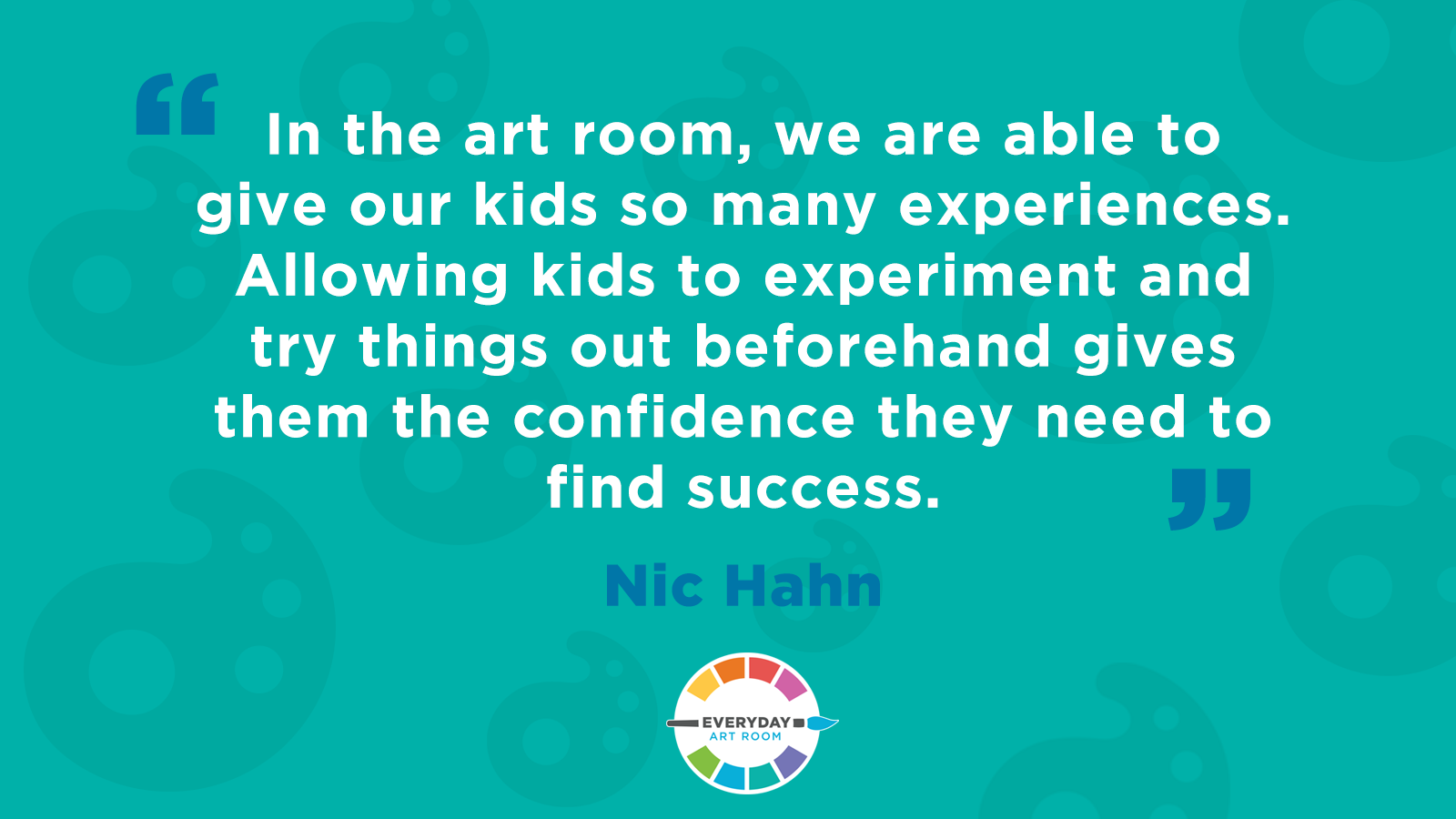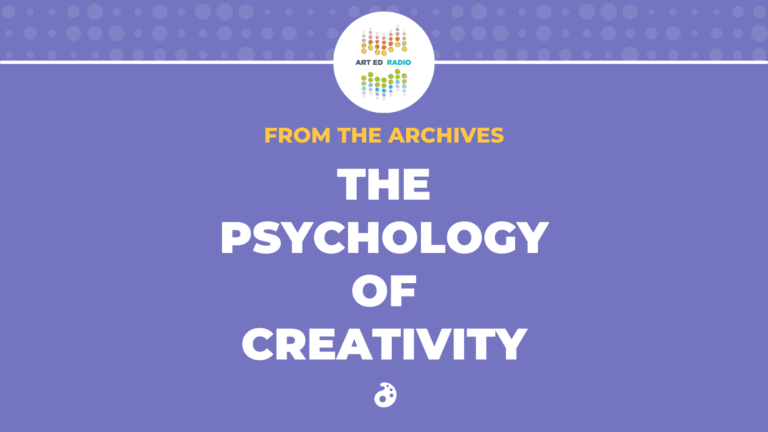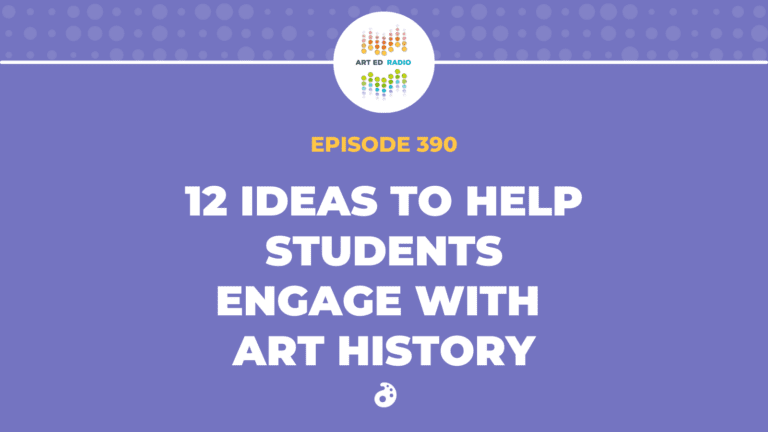In the art room, differentiation goes beyond just concepts. Allowing students to really explore the materials, evaluating skills, and looking at ideas are all necessary in the art studio. In this episode, listen as Nic discusses some of her best ideas for differentiation and tells you how you can meet students at their level. Full Episode Transcript Below.
Resources and Links
- Decoding Differentiation for the Art Room
- Differentiation in the Art Room (PRO Learning Pack)
- Simple Ways to Provide Options for Differentiation

Transcript
Nic: I have been following a hashtag on Instagram. It’s #aoeustudent. These are students for the Art of Education University’s master’s program, and it’s been really fun to watch these hundreds of posts over the last couple of months because I’m seeing some huge development in what people are posting. I’m seeing them growing as art educators and I can see the influence of each other in this program.
When I took my master’s program, it was roughly 10 years ago and I did definitely grow during my master’s program. I took it with a local university here in Minnesota and I met with my cohort once a month, but I was the only art educator in this group. In fact, I was the only specialist in this group, so I really didn’t have that camaraderie and that understanding the way that I feel is happening with the master’s program with the art of ed. I did, however, spend a lot of time considering differentiation in my classroom, and that’s what we’re going to talk about today. How to differentiate for your students in your classroom. This is Nic Hahn, and this is Everyday Art Room.
When thinking about differentiation, one of the main big ideas I had to come to terms with is that just because a group of people were born the same year doesn’t mean that they hold the same tools. It doesn’t mean that they’re going to come to you with the same abilities. This one was easy for me to understand, but what I’ve come to understand over the years is that not every section or student will come to you with the same set of tools.
For example, often when I’m lesson planning, I’m thinking about a lesson and I’m thinking about what grade level I’m going to teach this to. Well, sometimes that doesn’t really correlate because I might have a group of kids come through that is so beyond their years and I can really push them and do lessons that I might have tried with older grades. Other years, I have a group or a whole entire grade level that I feel maybe they would be more successful if I brought down the level a little bit and tried to reteach some of the concepts that, in the past, this particular grade level has already come to me with, but I’m noticing that this group maybe doesn’t have the same set of tools. Bringing my lesson plan up or down according to the level of my grade level is important, and then breaking that down even farther from section to section.
As art educators, we teach multiple sections of the same grade, so you’ll have a third grade on Monday and a third grade on Tuesday and a third grade on Wednesday, and each of those sections have their own flavor. The older, the grades get, a lot of times, at least in my school, we start categorizing them or kind of shifting them into sections where maybe they are high learners in mostly reading or math and maybe lower learners or more basic learners in those same subject areas.
That does change the dynamic of the students that come into our classroom as well. Remembering that not all students are made the same because they were born the same year, remembering from year to year I might have to change my lesson plans according to the grades that come to me, and then remembering section to section these students are not all made equal either, it does leave for a lot of differentiation and teaching on the fly to a certain extent. Often I will start by doing a couple of techniques to figure out the level of my students right away so that I know how to best teach them.
When I was taking my master’s degree and we were talking about differentiation most often they were talking about concepts. Do students understand what I’m teaching them? Did they have the building blocks before in order to be able to obtain the new information that they’re learning? That is absolutely something we have to consider in the art room as well.
For example, a lot of times a teacher can identify what the students need to learn by giving them a pretest. There was a pretest that was probably the most successful to kind of explain this thought is in middle school, I would set up a still life, I’d turn on a lamp, and I’d have all the students draw this still life using shadow. I didn’t teach them any sort of shading or shadow prior to asking them to do this task for me. Most students looked at me like I was asking way too much of them, but I would definitely continue to talk to them and just say, “Hey, guys, some of you won’t be able to do this. Some of you absolutely have this already. It’s okay, no matter where you’re at, it’s okay, it’s okay. I just want to see what you know.” Then I would take that creation that they would make that first day, and I’d go ahead and just analyze who I think already had the concept and who needed an additional lesson.
The following day I was able to separate those two groups and say, “You know what? These guys, you already have this, you know how to shade and shadow. I can tell that you’ve had some practice in this. You guys, we’re going to do this lesson together. We’re going to learn how to shade and shadow so that you can be more successful with this project that we are going to work on.” I let one group kind of move ahead, I know that this group would move ahead and challenge themselves and still probably need the same amount of time that the group that I’m now pulling aside and reteaching or teaching for the first time, the basics, they’re going to use less time on their final project. Most of the time, my students would end their project at about the same time. It wasn’t actually adding something new on for a group of students. It was making sure that they had the tools to be successful for producing what I was asking them to make.
Math teachers do this too. They give pretests to see what students know the content and can move forward. But what a math teacher doesn’t have to do is consider the skill level of their students as well. I’m talking about the physical way that they can create. For art teachers we have to consider that for sure. I mean, think about it, we’re giving our students scissors and asking them to cut, well do they know how to hold a scissors? Do they know the proper way to move the paper and make cuts? Have they had experience cutting on a line? We need to determine all of that prior to asking them to perform that task.
A pretest is also appropriate for this. A lot of times what I will do is ask my students to make cuts for me on a piece of paper. You may have seen other teachers use this as well. I give them a piece of paper that already has some lines, maybe some straight lines, curved lines, zigzag lines, and I ask them to perform a cut. I ask them to cut all of those lines, put their name on it, and then gather that information. Maybe that’s just a five-minute activity and we take a look at it as a whole and I understand what I need to go over before we start working on our project. Sometimes I do make that more individual and I pull aside the certain students that I think just need a little bit more work or more education on how to use the scissors correctly. It can be a quick thing. I can just do a group assessment, have them all do this one task, take a look at it as a whole and decide if I need to hit some of the basics or sometimes I make it more individual.
Another thing that we need to do is we have to consider have the students ever use the materials we’re asking them to use? In the art room, we give our students so many experiences. We ask them to draw with pencils, paint with paint, watercolors, acrylic, maybe oil. I mean, we ask them to create sculptures out of paper and clay and paper clay. I mean, all of these different materials we have to give, or we get to give to our students to give them a full experience in the art studio.
When you are giving your students a new medium or a medium that they haven’t used for a long time, you have to make sure that they know the basics. A lot of times, I will let my students explore the material before we actually create our final project. For example, maybe I would ask my students to create with me in their sketchbook using oil pastel. I would give them maybe four or five different techniques to use oil pastel in their sketchbook so that they can kind of give it a try. Ask them to use multiple colors, see how they blend, see how they interact with each other, explain to them that they can experiment and explore on this page without any consequence. That gives them the confidence in the background to be able to make good choices on their final product.
Another example is paper clay or CelluClay. This was a brand new material for my students. A lot of times what I do just because of time is we just jump right into that final product, or at least that has been my practice in the past. I’ve changed that. I try to give my students practice before they make their final project. For example, when I was using CelluClay to make some really cool sculptures, bird sculptures with my sixth grade, I gave them a tiny bit of CelluClay the day before and I asked them to make a finger puppet. I would give them the CelluClay, they would spend some time just touching it and getting ews and gross out of the way. Then starting to understand the capabilities of this medium, how they were going to put things together, we would try to let that dry for a couple of days so that they can see, oh, if I don’t adhere it in this way, that’s going to pop off or if I don’t manipulate it or really smooth out this section, it’s just going to remain bumpy and I don’t want that for my final project.
Allowing students to really explore the materials, seeing what they can do as far as their skills and, of course, looking at the concepts to see if you need to hit some of those basic ideas before they can move on to the next part are all necessary in the art studio.
What can you do to bring all of your students to the same level or a level where we can move together as a group? Well, there’s a couple of different things that you can do. I kind of talked about giving individual lessons to smaller groups. That is a really successful way because smaller groups means more understanding and more awareness of the teacher for the individual student. When you give a pretest and a group is able to move forward, take that small group aside and have those conversations and have them learn in a small group.
Another way is to actually, if you have Flipd videos or videos that you can obtain online that still give the same concepts, you can share that with the students themselves, or, in my case, I happen to use something called Seesaw, an app called Seesaw, so I can share it with the parents. I ask the parents, “Hey, your kiddo had a hard time today cutting. Here’s some tips of how to work on that at home.” Sometimes this is a successful way to get support from parents at home, sometimes not so much. It’s okay. It’s at least an attempt of trying to put that support at home and showing them what they can support at home.
Another way that you could increase understanding outside of the classroom is to give an assignment. Once you teach them a little skill, let’s say that you’re teaching them how to fold paper in a certain way. You teach them in the last part of your class and then you say, “Okay, your assignment before you come to class next time is to teach someone else. Teach your mom, teach your dad, teach your brothers or sisters, teach your grandpa and grandma, teach your dog. I don’t care who your teach, teach them how to do this.” I make a big deal. I say to my elementary students, “Okay, now you’re going to pretend that you’re the teacher and if someone’s talking when you’re talking, make sure that you ask them to please listen. If they do it wrong, don’t get after them. Tell them, encourage them, say you can do it. I believe in you.” I give them all the words and the skills to teach their student. When you have students teach someone else, It creates deeper understanding of the concept.
So far we have talked about concepts and skill level and materials meaning places that you need to differentiate within the classroom. But we have not talked about procedures, and I will tell you this is probably the number one place that I spend most of my time bringing students to the same level.
When I talk about procedures, I’m talking about how students enter the classroom, the culture of the learning space, how students get their supplies and move throughout the classroom. This can definitely change the pace of your classes. I have found this to be the number one place, especially from section to section, where maybe I don’t accomplish the same amount of work from section to section or even from grade level to grade level, where I have to revisit these procedures on a regular basis to help my students be more successful in the classroom. They can have all the skills and knowledge that you could ever want for that grade level, but unless they can perform that action using the room in a proper way, staying on task for the studio time given, you’re just never going to have a product that actually proves their knowledge.
A lot of times what I have to do is reteach. There’s lots of different ways that I can reteach procedures of the classroom. One that I’ve been doing quite often is redos. For example, I might invite a class into my classroom and I’ll say, “Hi, guys, come on in and have a seat on the carpet.” Students will walk in and sit down on their sit spots, we’ve been practicing this for months. However, I will every once in awhile have a class that goes in, starts wrestling around on the carpet, doesn’t go to their sit spots, they’re wandering around the classroom ,touching things that they’re not supposed to be touching, and I walk in and the room is chaos.
Okay? Instead of getting after them and telling them how badly they all are behaving, we do a retry. I ask the students to line up like we’re leaving the classroom. We walk back out into the class or the hallway and come in the in door. I’m lucky to have an out door and in door. Then, while in the hallway, I reiterate my expectations of their entering the classroom. I say, “Boys and girls, when you come into the classroom, you’re going to show me that you’re ready to learn by sitting on your sit spot, sitting on your bottoms, your hands are to yourself, you’re not touching others, and bonus points if you’re giving me a big smile.” Then I look down for just a second, I bring my eyes back up to the students, and I pretend like I have amnesia. I say, “Hey guys, welcome to the art classroom. Come on in, have a seat at your spot.” They look at me like, “Okay, Ms. Hahn, we’ll give this a try again.” They all walk in and majority of the time it’s successful. We have revisited my expectations. They come in in a different attitude, I’m not getting after them making them feel bad, we just tried it again.
I find myself in the elementary room doing this often for lining up for materials, making a line, taking a short amount of time at the front of the line, making your decisions. Okay, lining up to go get pencils, they align up, they take a pencil, and they move on. If they need more time to think about which pencil they’ll choose, they can go to the end and they can have all the time that they need to make a good choice. We might have to revisit this several times throughout the year. I might say, “Go get in line to get whatever,” and they make a big clump or they run to the front of the line and push each other. Well, we go back and we just do a retry.
A lot of times I will have procedures recorded as well. I’ll ask students to follow the instructions by a video, a prerecorded video. If they’re lucky, I will actually have them record the video. This is an amazing tip too, asking them to show other students the proper way to do things such as, I don’t know, a gallery walk, not running around the classroom, hands behind your back, standing nice and tall, looking at the artwork silently and thoughtfully. Then I ask them to make this action as I record. This allows them to teach other classes as well as highlight the expectations that you have for them.
We have materials that we have to go over, procedures that we go over, the skill level of each of our students, and the concepts. These are all things that students will come to us at different levels. In order to move forward in any of these areas, we have to make sure that our class is unified or at least fairly close to unified to move forward.
Differentiation in the art studio is a huge idea. I mean we talked about procedures today, materials, making sure that students had exposure to materials before using them, the skill level of their little hands, and also the concepts, making sure that they know the building blocks that they need to perform like you’re asking them to do. This is huge, so don’t become overwhelmed with this huge, huge idea. Get started just concentrating in one area. Are you going to focus on concepts and creating some pre- and post-tests or at least the pretest to make sure that your students have what they need, the knowledge? Are you going to start working on skills, maybe creating some Flipd videos, working on skills, how to hold the scissors, how to hold your pencil? Are you going to maybe make some signs in your classroom that really highlight what your expectations are for procedures throughout the classroom so that you can have a classroom that is independent and working well? Or are you going to make sure that your students have the opportunity to use the mediums before actually putting them on their final product?
Don’t take all of this at once, take little bits or improve on what you’re already working on. Thanks for joining me again today and I will talk to you in a week.
Magazine articles and podcasts are opinions of professional education contributors and do not necessarily represent the position of the Art of Education University (AOEU) or its academic offerings. Contributors use terms in the way they are most often talked about in the scope of their educational experiences.



